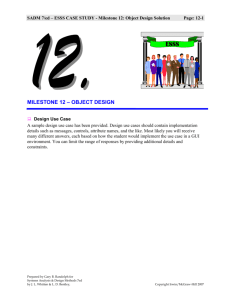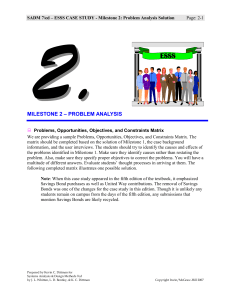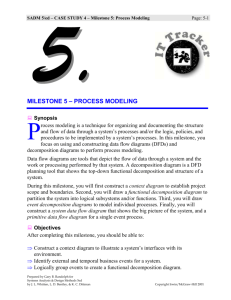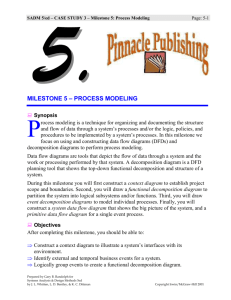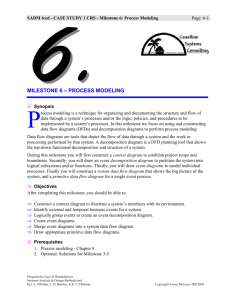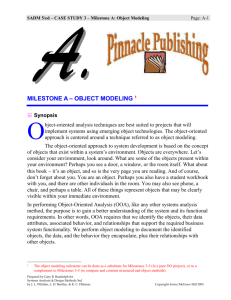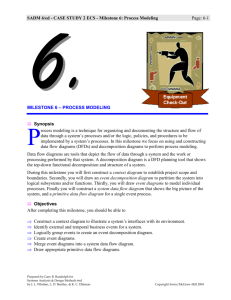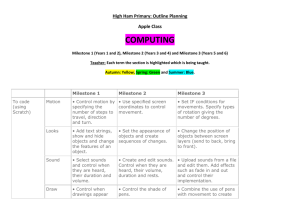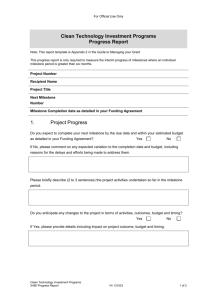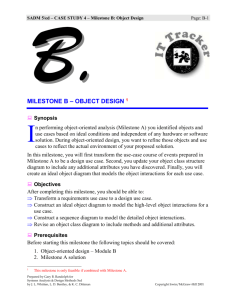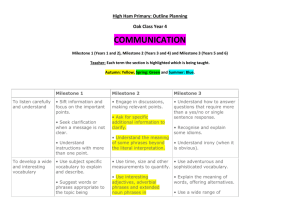Case Study ESSS
advertisement
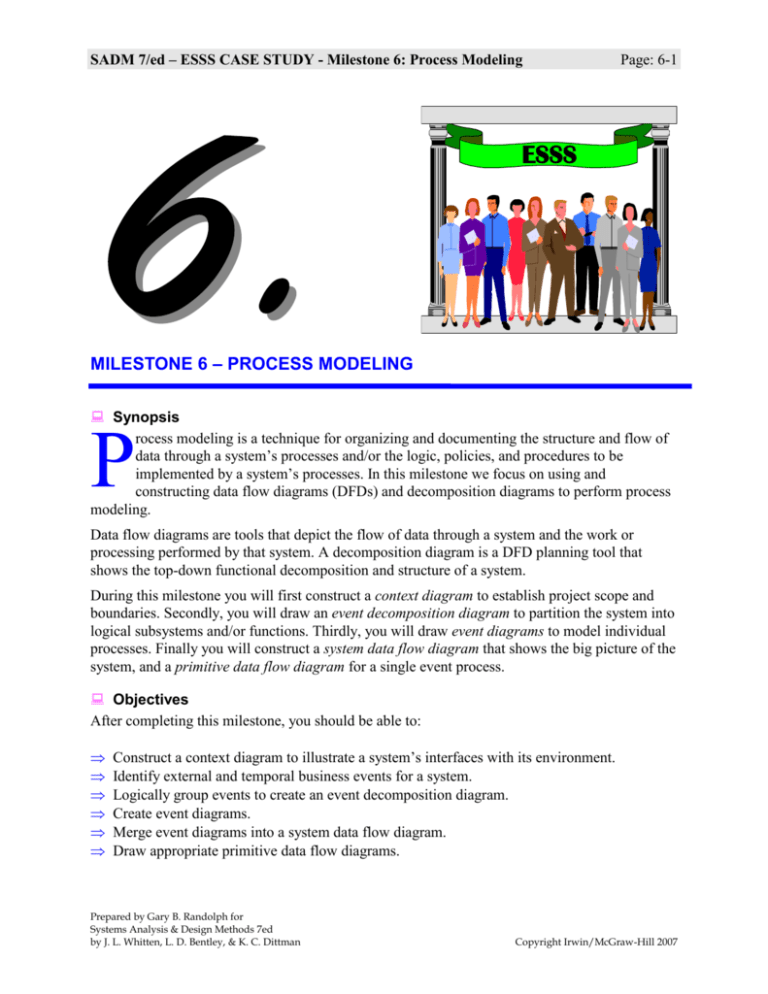
SADM 7/ed – ESSS CASE STUDY - Milestone 6: Process Modeling Page: 6-1 ESSS MILESTONE 6 – PROCESS MODELING Synopsis rocess modeling is a technique for organizing and documenting the structure and flow of data through a system’s processes and/or the logic, policies, and procedures to be implemented by a system’s processes. In this milestone we focus on using and constructing data flow diagrams (DFDs) and decomposition diagrams to perform process modeling. P Data flow diagrams are tools that depict the flow of data through a system and the work or processing performed by that system. A decomposition diagram is a DFD planning tool that shows the top-down functional decomposition and structure of a system. During this milestone you will first construct a context diagram to establish project scope and boundaries. Secondly, you will draw an event decomposition diagram to partition the system into logical subsystems and/or functions. Thirdly, you will draw event diagrams to model individual processes. Finally you will construct a system data flow diagram that shows the big picture of the system, and a primitive data flow diagram for a single event process. Objectives After completing this milestone, you should be able to: Construct a context diagram to illustrate a system’s interfaces with its environment. Identify external and temporal business events for a system. Logically group events to create an event decomposition diagram. Create event diagrams. Merge event diagrams into a system data flow diagram. Draw appropriate primitive data flow diagrams. Prepared by Gary B. Randolph for Systems Analysis & Design Methods 7ed by J. L. Whitten, L. D. Bentley, & K. C. Dittman Copyright Irwin/McGraw-Hill 2007 SADM 7/ed – ESSS CASE STUDY - Milestone 6: Process Modeling Page: 6-2 Prerequisites 1. Process modeling - Chapter 9 2. Optional: Solutions for Milestone 1-5 Assignment The preliminary investigation and problem analysis phases of the methodology have been completed and you understand the current system’s strengths, weaknesses, limitations, problems, opportunities, and constraints. You have already built the data model (Milestones 4 and 5) to document business data requirements for the new system. You now need to build the corresponding process models. Activities 1. If you have not already drawn a Context Diagram in Milestone 2, draw one now based on the meeting transcript in Exhibit 2.1 of Milestone 2 plus the accompanying use-case (event/response) matrix in Exhibit 6.1. Note that not everything in the transcript is related to the Context Diagram. 2. Given the accompanying use-case (event/response) matrix in Exhibit 6.1, draw the Event Decomposition Diagram. For background information on each use case, see the meeting transcript in Exhibit 3.1 of Milestone 3 and Exhibit 4.1 of Milestone 4. 3. Given your decomposition diagram from above and the use-case matrix, draw Event Diagrams for “Search Employee Directory” and “View United Way Participation” events. Use your data model from Milestones 3 and 4 as an attribute reference. Also, state any assumptions you make. 4. (Optional) Merge your event diagrams from #3 above into a System Diagram. 5. For all transaction processes described in the accompanying narrative, draw the Primitive Data Flow Diagram. Please email the deliverables to the TA and the instructor References: Completed Solutions from Prior Milestones Completed Use-Case (or Event-Response) List Exhibit 6.1 Primitive Diagram Narrative(s) Exhibit 6.2 Prepared by Gary B. Randolph for Systems Analysis & Design Methods 7ed by J. L. Whitten, L. D. Bentley, & K. C. Dittman Copyright Irwin/McGraw-Hill 2007 SADM 7/ed – ESSS CASE STUDY - Milestone 6: Process Modeling Page: 6-3 Deliverables: Context Diagram: Due: __/__/__ Time: _______ Decomposition Diagram: Due: __/__/__ Time: _______ Event Diagrams: Due: __/__/__ Time: _______ System Diagram: Due: __/__/__ Time:_______ Primitive Diagram(s): Due: __/__/__ Time: _______ Prepared by Gary B. Randolph for Systems Analysis & Design Methods 7ed by J. L. Whitten, L. D. Bentley, & K. C. Dittman Copyright Irwin/McGraw-Hill 2007 SADM 7/ed – ESSS CASE STUDY - Milestone 6: Process Modeling Page: 6-4 ADVANCED OPTION Exhibit 6.1 is a partial use-case (event/response) list. Add the following maintenance Use-Cases: Add a Site, Add a Building, Add a Room, Add a MailStop, and Add a Department. Draw the Event Decomposition Diagrams and the System Diagram based on the complete list. Event Diagrams: Due: __/__/__ Time: _______ System Diagram: Due: __/__/__ Time: _______ Milestone’s Point Value: Prepared by Gary B. Randolph for Systems Analysis & Design Methods 7ed by J. L. Whitten, L. D. Bentley, & K. C. Dittman _______ Copyright Irwin/McGraw-Hill 2007 SADM 7/ed – ESSS CASE STUDY - Milestone 6: Process Modeling Page: 6-5 Exhibit 6.1 Below is a Use-Case list for the major processes of the system. For more information on each of these use cases, see the meeting transcripts in Exhibit 3.1 of Milestone 3 and Exhibit 4.1 of Milestone 4. Other events exist for basic data maintenance (add records, delete records, etc.) Actor(s) Event (or Use-Case) Trigger Responses System reports all employees that match search criteria, listing phone numbers, office location, department, job title, and supervisor. System updates Employee, EmergencyContact, UnitedWayContribution, and/or MiscDeduction data stores System adds records to Employee and related data stores System generates report. Employee Search Employee Directory Employee selects search criteria (first or last name, department, location, job title, or supervisor) Employee Update Employee Profile Employee has information to update Staffing Dept Enter New Employee Profile Employee begins work and submits initial forms Manager View United Way Participation Update Employee Secure Data Perform Ad-hoc Query and Reporting Perform Employee Detail Lookup Manager requests report Staffing Dept Manager Employee Manager HR Manager HR Perform Employee Group Lookup Promotion, job change, or relocation paperwork Manager submits SQL User selects employee from list of employees (subject to security restrictions) User selects search criteria (job code, building, department, salary/wage range, home city or phone exchange, employment status, etc.) System updates data for pay rates or job title or supervisor. SQL is run against database to generate report. System displays option for kind of information to be displayed. If a kind of information is selected, system displays name/address, salary/wage, location, emergency contact, deduction options, etc. System displays all employees that match criteria. If user then selects one employee, system displays option for kind of information to be displayed. If a kind of information is selected, system displays name/address, salary/wage, location, emergency contact, deduction options, etc. Prepared by Gary B. Randolph for Systems Analysis & Design Methods 7ed by J. L. Whitten, L. D. Bentley, & K. C. Dittman Copyright Irwin/McGraw-Hill 2007 SADM 7/ed – ESSS CASE STUDY - Milestone 6: Process Modeling Page: 6-6 Exhibit 6.2 Use the following narrative to construct the Primitive Diagram for the Search Employee Directory event. The employee enters search criteria for first or last name, department, location, job title, or supervisor. The system displays all employees matching the criteria with links to detailed information for each employee. The user clicks on detail link for an employee. The system will display the phone number, employee's office location, department, job title, and supervisor. Prepared by Gary B. Randolph for Systems Analysis & Design Methods 7ed by J. L. Whitten, L. D. Bentley, & K. C. Dittman Copyright Irwin/McGraw-Hill 2007
